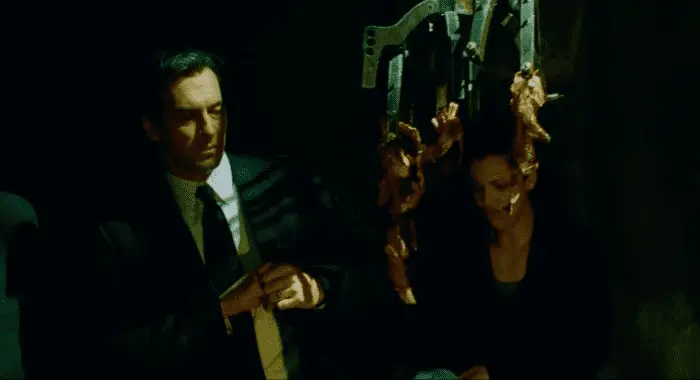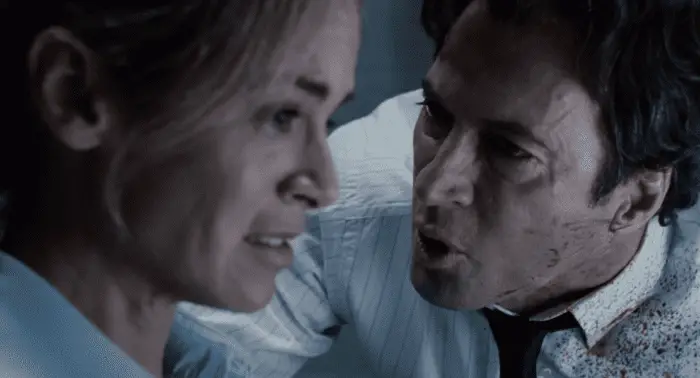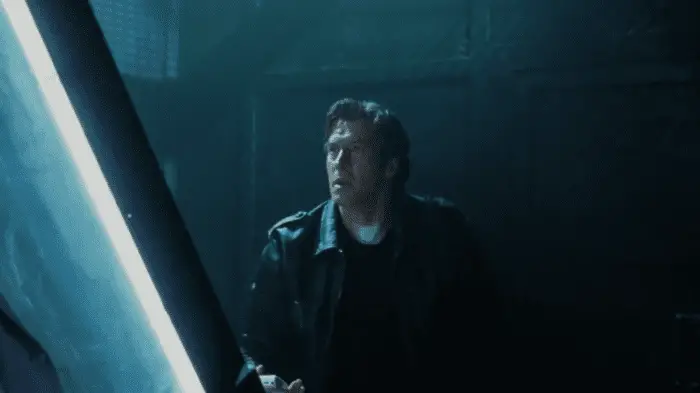Aspect of the Saw films that intrigues fans is the various iconic characters that we either love or love to hate. Jigsaw himself, John Kramer (Tobin Bell), is the obvious one here, but also accomplices Amanda Young (Shawnee Smith), Detective Mark Hoffman (Costas Mandylor), and inevitably-revealed Dr. Lawrence Gordon (Cary Elwes).
There’s a lot of focus on villains, so I’m here to discuss the much-liked protagonist of Saw IV and Saw V, Special Agent Peter Strahm (Scott Patterson). These two films are often considered to be among the weaker ones, but there’s still value in them. Admittedly, I’m also biased when it comes to Strahm since I was already a huge fan of Patterson from his character Luke Danes in Gilmore Girls—but his performance in Saw is certainly worth reflecting on.
Saw IV
We first meet Strahm at a crime scene at the beginning of Saw IV, along with his partner Special Agent Lindsey Perez (Athena Karkanis). Their liaison, Detective Allison Kerry (Dina Meyer), was killed in a Jigsaw trap, which is why the two agents have been brought in to work the case alongside Detective Hoffman. Strahm’s first words are “open the door and you will find me,” reading one of Jigsaw’s clues left at the scene. This is the final clue for both himself and Officer Daniel Rigg (Lyriq Bent) that comes into play at the end of the film; Rigg will open the final door to find Hoffman, revealed to be the accomplice, and Strahm will open another door to find the deceased John Kramer.
Stoic and stony-faced, Strahm is instantly portrayed as a classic hardened detective. He pretty much immediately figures out that Amanda (the known accomplice at this point) didn’t construct Kerry’s trap as she wouldn’t be large or strong enough to rig it, and neither would Kramer. No time is wasted in showing off Strahm’s intelligence and capability in his job. Once we later discover that Hoffman is the accomplice responsible, this scene is tinged with irony; Strahm is theorizing about the killer right in front of him. The tension between the two men is also created by Strahm telling him, “we’re here to find the person your department couldn’t, Detective.” In retrospect, Hoffman is that person, but without knowing that, Strahm is still insulting Hoffman’s abilities and positioning himself as the smarter cop. The look Hoffman gives him at the end of the scene tells us the competition between them is going to be a central focus, which it is for this film and the next.

Giving some background information, Perez mentions to Strahm when they’re alone that Kerry said two police officers might be in danger in her final message before she died. Perez encourages Strahm to inform Hoffman, but he refuses, saying there’s no need to cause a panic and that it’s his call. Although the two agents make a good duo throughout Saw IV, Strahm is clearly the one with the upper hand and authority. His reluctance to warn Hoffman also emphasizes his lack of regard for him and exacerbates the tension between them.
The actual ‘games’ in Saw IV are focused on testing Rigg, but Strahm is heavily involved with tracking him and attempting to catch the killer along the way. As soon as he finds photographs of Hoffman in Rigg’s apartment and realizes he’s now in danger, Strahm requests his location. Sure, he’s stubborn and does his job on his own terms, but as soon as a colleague’s life is on the line, he will do what is necessary to protect them. Photos of Detective Eric Matthews (Donnie Wahlberg) are also found in Rigg’s apartment, and Strahm once again makes an instant accurate deduction that Matthews is still alive and has been held prisoner by Amanda since Saw II. He knows Jigsaw and his accomplice through and through, so he is by far the best person on the case.
Saying this, Strahm is unfortunately taken in by a red herring. Noticing photos of Jigsaw’s ex-wife Jill Tuck (Betsy Russell), he begins to strongly suspect her of being the accomplice. Strahm brings her in for interrogation and so begins a sort of good cop/bad cop routine between him and Perez. Contrasting approaches to the case and the job is what separates Strahm and Perez, but what also makes them a good, balanced team; where Strahm is very objective and removed in how he looks at the facts and evidence before him, Perez has more sympathy with victims and is emotionally affected. After a forensic scientist gets killed by a crossbow being triggered at one of the crime scenes, Perez is visibly shaken while Strahm is completely unfazed and continues to ask questions to figure out where Jigsaw’s new lair is.
When Jill recounts her ex-husband’s serial killer origin story involving the traumatic loss of their unborn child, Strahm shows zero compassion and claims he isn’t “buying it” as a motive for Kramer. (Just a fun little side-note here: at the end of the final flashback to Jigsaw’s origins, we see Kramer unveil a glass box lined with shards of glass right before we cut back to Strahm—the very box used in Strahm’s final test at the end of Saw V. Nice bit of foreshadowing!) He’s extremely intimidating and aggressive towards Jill, and this increases tenfold when Perez is hit by a shrapnel bomb planted by Jigsaw. As the interrogation goes on, Strahm raises his voice, swears, and even traps her against the wall while yelling in her face.

“You see this? This is my partner’s blood. She’s fighting for her life right now because of your lunatic husband!”
The focus here is entirely on Perez and how distraught Strahm is that she’s injured; he doesn’t really give a damn about Jigsaw’s other victims on an emotional level, so this emphasizes how he is incredibly loyal to particular people he cares for. It’s one of those situations where nothing affects him until you hurt that one person, and then you’re done for. Strahm clearly has issues with processing his emotions, as he expresses this via extreme anger or repression. We catch a glimpse of vulnerability as he looks concerned and fondly holds Perez’s hand while she’s on the stretcher, but shortly afterward, he violently trashes his office in distress and regains focus by once again channeling his energy into looking at the evidence.
Clocking the “four walls build a home” clue, Strahm figures out which building is Jigsaw’s lair. In another classic twist, Strahm opens the door and is faced with the conclusion of Saw III—the corpses of Dr. Lynn Denlon (Bahar Soomekh), Amanda, and Jigsaw himself. Lynn’s husband, Jeff Denlon (Angus MacFadyen), is inconsolable and aims his gun at Strahm, who shoots first in self-defense and kills him. This firmly closes the book on the events of both Saw III and IV.

Simultaneously, we get the reveal of Hoffman as the accomplice. He circles back to the lair and shuts Strahm in the room with the iconic “game over” line, but…
Saw V
…it’s not over! After traditionally opening on a trap, Saw V continues from where we left off. This time, however, Strahm finds a secret door. Upon kicking it open, he finds a tape.
In the usual analytical and critical tone, Jigsaw describes Strahm as having an “insatiable hunger to uncover the truth” that could “push [him] deeper into the abyss”—remember that one for later. The detective is advised not to proceed through the doorway. Of course, he ignores this helpful suggestion, and with an (admittedly satisfying) “f*ck you”, Strahm goes through and is caught by a figure in a pig mask, aka Hoffman. Cue one of the most horrifying traps in the Saw franchise!
Strahm wakes up with his head inside a glass box with a rusty metal frame, and so begins his first trap. The box fills with water until his head is completely submerged. What’s so impressive about this trap is that Patterson had to actually have his head stuck underwater in there since the close-ups didn’t allow for a stunt double. In an extremely badass move, Strahm takes a pen out of his pocket, empties it, and stabs it into his neck, performing a tracheotomy that allows him to breathe. It’s one of the coolest moments in the franchise. All the more brilliant is that Hoffman intended for Strahm to die in this trap, what with leaving him no tape once he was inside the box, but obviously wouldn’t expect him to survive by performing such a breathtaking (sorry, couldn’t resist) feat. The look on Hoffman’s face once he sees that Strahm is alive is priceless, once again fuelling their rivalry. The stakes are even higher now that the audience is aware that Hoffman is the villain.

Frustratingly, Hoffman immediately gets promoted to Detective Lieutenant for saving Jeff and Lynn’s daughter, Corbett Denlon (Niamh Wilson), and ‘closing’ the Jigsaw case. In direct contrast, Strahm is taken off the case and put on medical leave by his boss, Agent Dan Erickson (Mark Rolston). As a further hit, we discover that Perez passed away in the hospital. Strahm has essentially lost everything and is in a regressed position now from where he was at the start of the previous film. We see him sitting by Perez’s empty, bloodstained hospital bed and get flashbacks to her attack; he’s rehashing the event in his mind and convincing himself there’s a way he could have saved her. Although it’s an irritating example of fridging, Perez’s death and Strahm’s reaction to it garners more sympathy for him.
To rub salt in the wound, Hoffman walks in. Strahm tells him (in a very hoarse voice) that Perez’s last words were “Detective Hoffman.” The two men ask each other how they survived and Strahm says “on a gurney with a f*cking hole in my throat,” highlighting Hoffman’s comparatively light injuries. Furthermore, he says “Jigsaw doesn’t make mistakes” and points out how Hoffman’s whole department died except him. Everything Strahm says here builds the highly justified case against Hoffman; he doesn’t make an effort to hide his suspicion of him. Strahm is excellent at drawing up the evidence and formulating an accurate theory (excluding the whole thing in Saw IV with Jill, of course).
Here’s where it starts to go downhill a little. In Saw IV, Strahm was exceedingly intelligent and fast at both forming and acting on his suspicions, but as I saw someone describe it, in Saw V he’s basically going around figuring out the plots of Saw III and IV. His skill is, therefore, undercut slightly by how much longer it takes him to put the (jigsaw) pieces together. We as the audience already know all of this, so the only new information we’re getting is some poorly shoehorned-in flashbacks of Hoffman’s rather uninteresting origin story. But that’s a criticism of Hoffman rather than Strahm. I’d also argue that it’s more difficult for Strahm in Saw V since he’s having to work entirely alone and isn’t technically allowed to work on the case anymore.
So, Strahm uses his pass to sneakily get into the precinct and access files. He discovers that Hoffman’s sister was murdered by her boyfriend, who died in the Jigsaw trap we saw at the start of the film. Hoffman acted as a Jigsaw copycat so his revenge would fly under the radar, but of course, Kramer noticed and ended up hiring him as an accomplice. Strahm gradually figures this out—I swear you can see the cogs slowly turning in the many shots of him staring at files. At one point, he bumps into Erickson in the precinct and explains he was gathering his belongings and on his way to go rest up, but we know he’s lying.

Strahm visits multiple Jigsaw crime scenes (almost like a fun little tour: “and on your left, we have one of Jigsaw’s best hits—The Rack!”) to try to put himself inside the killer’s shoes. Those flashbacks to Hoffman being mentored by Jigsaw are intercut with these scenes, drawing up visual parallels to reflect the thematic ones between Strahm and Hoffman. They’re polar opposites being pitted against one another, but they’re also both detectives who happened to have taken different paths: one strictly against Jigsaw, one having formed an alliance with him.
His personal investigation brings with it the realization that Hoffman intended for all people to die in the final games in Saw III and IV to paint himself as the hero, which he did via the promotion and capturing newspaper headlines. Once again, Strahm lashes out angrily by flipping the bed over. Unable to contain his rage, the detective makes a fatal mistake by setting out to arrest Hoffman alone. Previously, he’s been shown to go out on a limb every time he suspects someone or something, often without backup. This time is no different, but his final actions make all the difference.
Entering the room Hoffman has led him to, Strahm finds the large glass box lined with glass shards and a tape inside. The tape tells him that his dedication is to be admired and asks if he has “learned anything on [his] journey of discovery.” Strahm is again instructed to trust the tape and enter the box to survive the game. Naturally ignoring the warning, Strahm waits in hiding for Hoffman to arrive; their brief fight ends in Strahm locking him inside the box and triumphantly declaring, “I got you, you motherf*cker.” Sigh. Of course, this is his downfall. The box descends below the floor and out of the way of the metal walls that begin closing in, placing Hoffman in the safest position.
It’s understandable that Strahm would be hesitant to trust a serial killer’s tapes, but come on, we should all know by now that he gives his victims a fair chance of survival. Sure, Hoffman doesn’t have the best track record, but Strahm simply doesn’t learn from the first tape telling him to avoid the room that contained the trap to kill him. This one’s just even more inescapable.
The walls close in and leave Strahm a pile of bloody goop—not before we see his arm snap in the most “AAAUURRGHH”-inducing way possible. It’s absolutely crushing (in more ways than one) and one of the grossest deaths to watch in the franchise. Even more devastating is that while all this has been happening, Erickson was tracking Strahm’s phone which Hoffman stole and planted in his own lair. Keeping in mind other evidence such as the missing files from the precinct, Erickson, therefore, deduces that Strahm is the Jigsaw accomplice. Not only is he dead, but his lasting reputation is defamed (at least for a little while until Hoffman is caught).

And so ends Peter Strahm’s Saw arc. Most characters in the franchise don’t have a great outlook from the start, and especially not detectives. Strahm’s persistence and obsession with the Jigsaw case set him up for a fall, as these traits are usually the undoing of any cop involved, such as Detective David Tapp (Danny Glover) from the first Saw. His death, therefore, wasn’t unexpected. Despite this, Strahm’s intelligence, drive, and fearlessness made him easy to side with. Patterson brought fierce energy to the role which was refreshing and enjoyable to watch. Not only did Strahm make his way through two Saw films, but he also survived an ‘impossible’ trap; if that doesn’t impress you, I don’t know what will!


